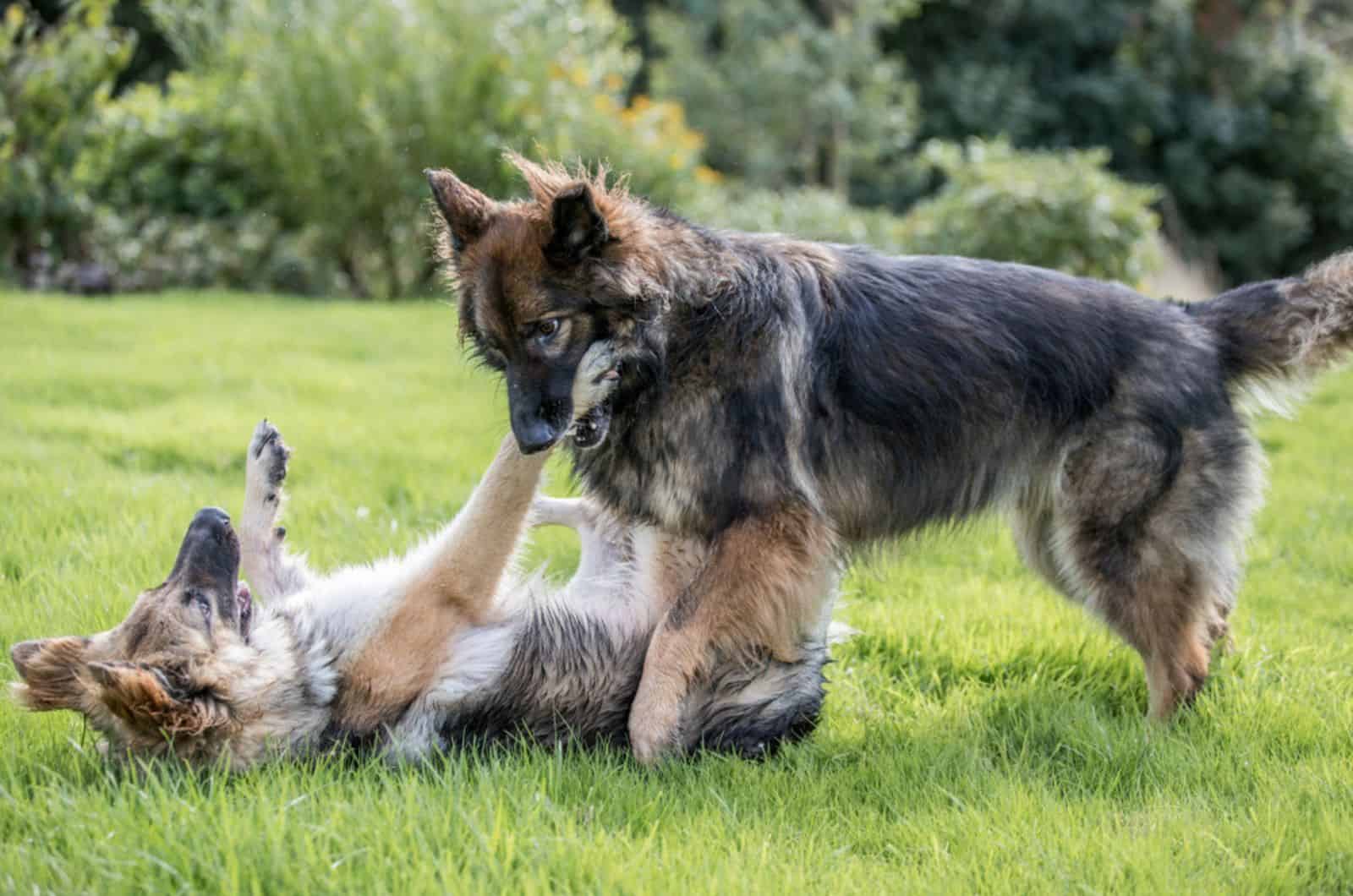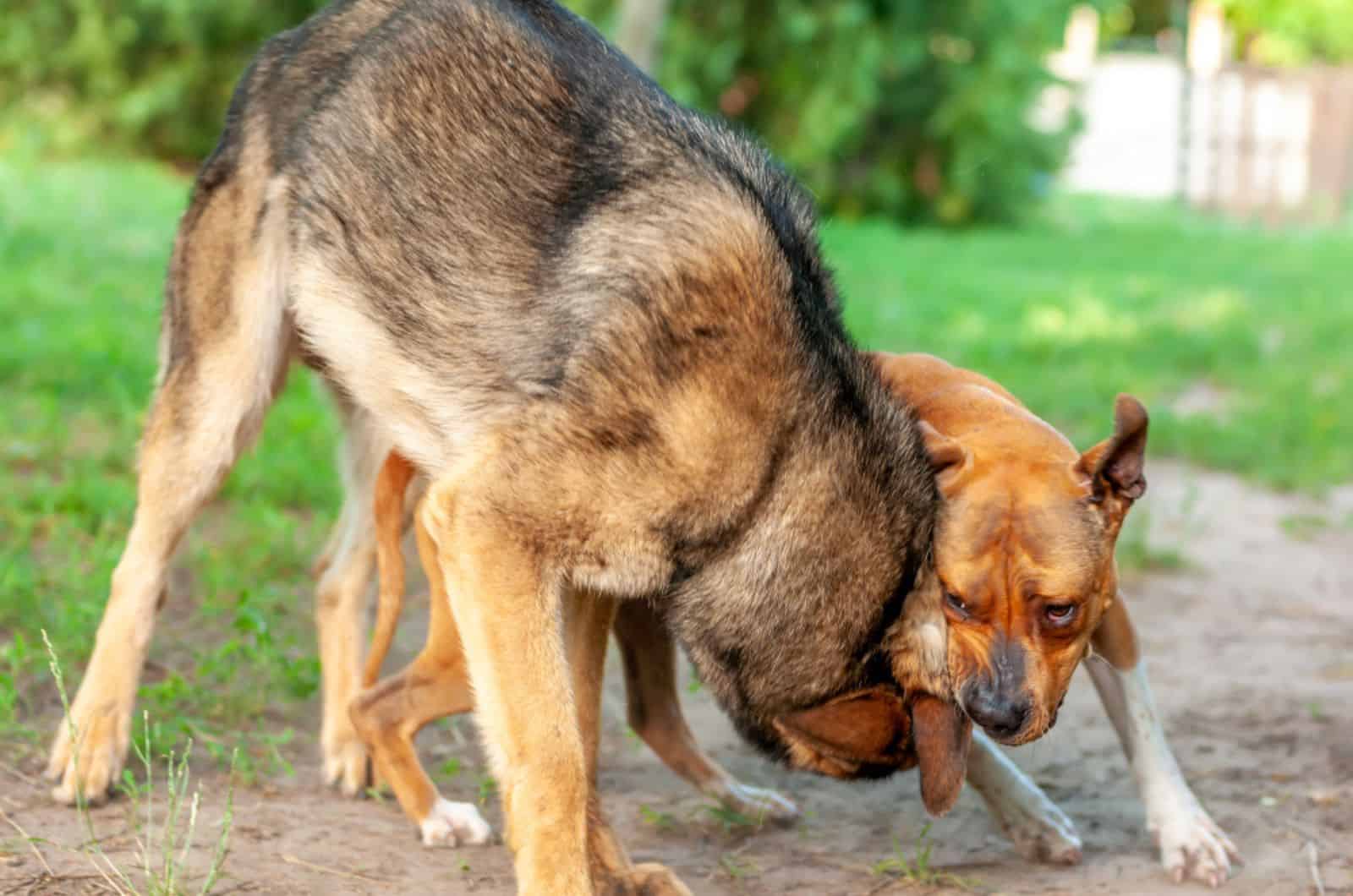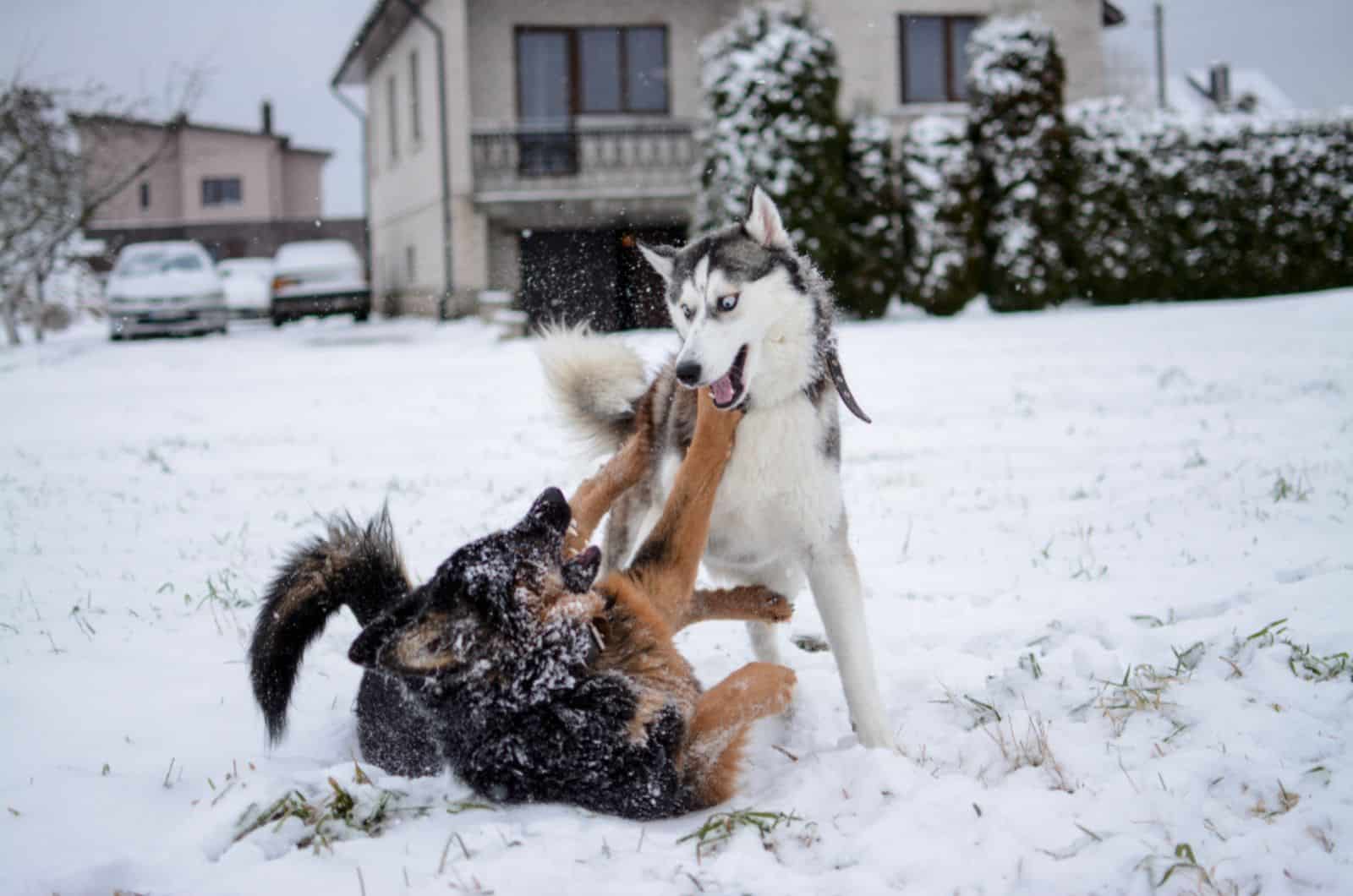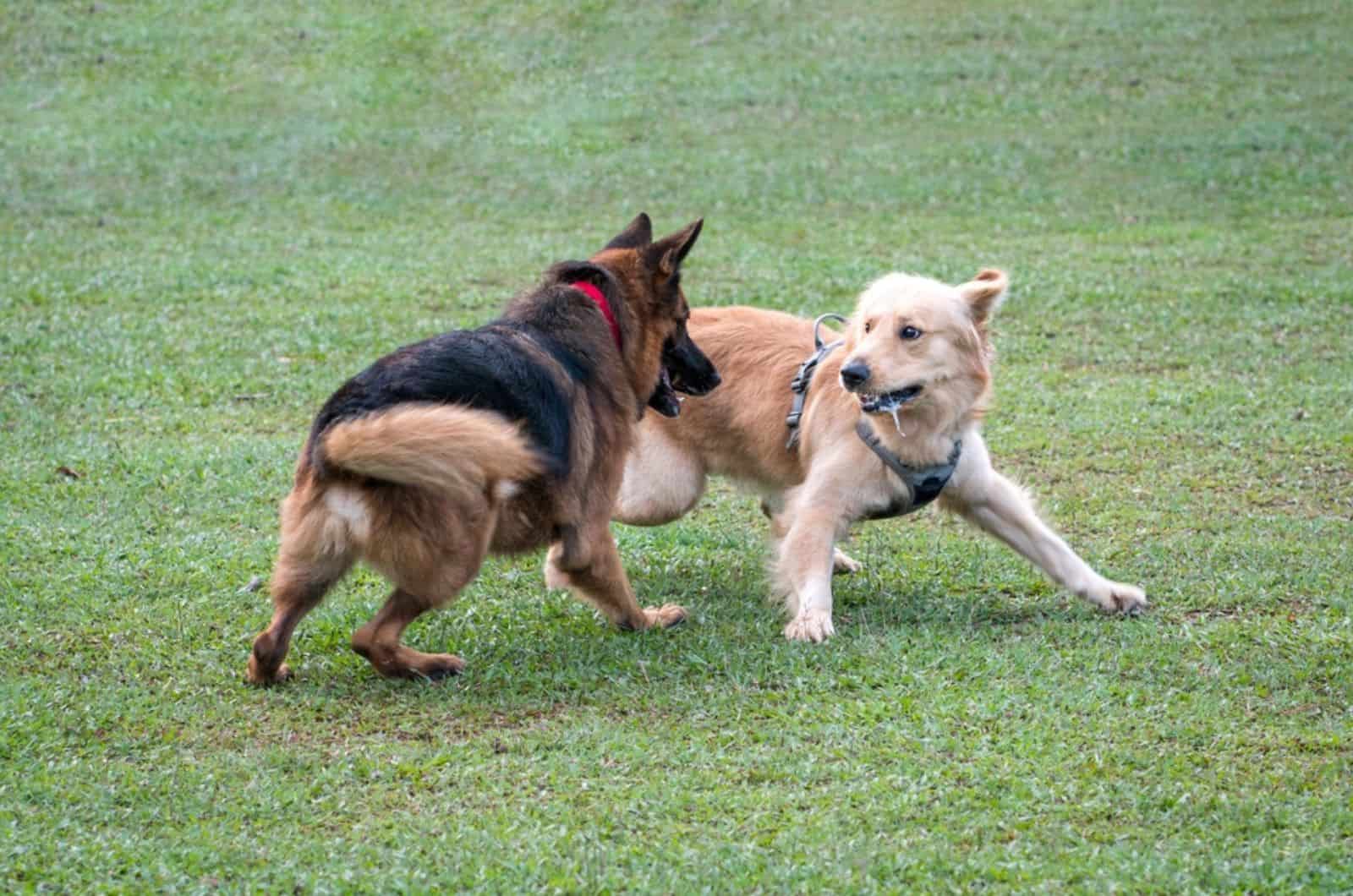German shepherds are outstanding creatures with much love for their owners, but playing with their own can seem brutal to us. Should you let German shepherds play fight, despite it looking like they are out to destroy one another?
The answer has some prerequisites, so it will depend on an individual dog, rather than the entire breed. Whether puppies or adults, GSDs love to play fight, and it is not a matter of should you let them play fight, but when and how.
Let me share some of my dog training and behaviorist experience with you as we venture into a GSD behavior hole. German shepherds in wonderland.
Playtime Is Not Something To Be Taken Lightly

In the dog world, playing with your peers is more than just having fun. Just like their progenitors, the wolves, German shepherds learn their social hierarchy and rank by playing. The strongest member of the pack will most likely be the leader, while others are his subordinates.
If you saw your GSD getting extremely excited when it sees his playtime companions, it is not just because excitement overwhelms it. Structure is essential for a dog to be happy. Dogs whose owners do not provide structure usually impose themselves as bosses.
Between dogs, there is no such mistake as letting someone be the boss. You give it your best shot and, if you get toppled, you are happy with your position. However, the subordinates all know that their leader will take care of them.
Although the chances of your German shepherd getting into a bad altercation with another dog or animal is small, play fighting translates directly into actual fighting. What puppies learn during playtime will become a skill that could save their lives one day.
These social interactions and preparations for a fight should not be discouraged. Regardless of breed, this behavior is what makes them a dog. A dog that is playful and eager to learn is nothing to get worried about. It is much worse to have an insecure or fearful canine.
How Proper German Shepherd Play Fight Looks
Any dog breed, including the GSD, bases its intercommunication on body language. Luckily, we are pretty good at reading the signs dogs give us, and with experience, it only takes a glance to realize what is going on.
When a German shepherd wants to show another dog that he is excited to play, they will do the front body bow with a high tail position and a wag. There might also be high-pitched barking and a funny growl as the impatience sets in.
Make sure you differentiate between the types of growls. We got you covered on that front with this article on nine reasons a German shepherd will produce that unique growl.
A common behavior is smacking the front paws on the ground in front of the other dog to speed up the pondering over playing. Similar to this, any ridiculous acrobatics send the same message to other dogs, and unintentionally people, too.
If the German shepherd gets even the smallest reaction from the other dog, you might see some belly showing and gentle muzzle poking or “biting”. By this time, every dog involved will be up for a good time.
Key Signs That Your German Shepherd Is NOT Asking For Playtime

Some of these body language messages can be easily mixed up by dog owners. You have to keep an eye out for the other dog(s)’ signals as well. As the leader of the pack, you must make the right decisions before things escalate.
A fixated gaze is never a good sign. Keeping intense eye contact with other dogs means your GSD or the other dog has set its sights on a target. Although dogs will communicate their disinterest in playing, learn to decipher the clues.
A closed mouth, showing teeth, or shaking lips mean that the atmosphere is not set for playful interaction. A tense tail without erratic movement is also a warning sign that the intentions are not good. Here is a quick guide on how to interpret GSD tail position.
Having its tail between the legs, ears set back, or a cowering body posture can imply anxiousness in a dog, so make sure you read all about the five reasons a GSD would feel that way.
Raised heckles (hair in the middle of a dog’s back) should be an immediate trigger for you to remove your dog from the situation. It does not matter if it is your German shepherd or another owner’s dog, prevent a bad situation as soon as possible.
Escalation from rough play to a dog fight can be easily spotted when one dog starts chasing all other dogs. In the canine world, taking turns between alpha and follower is normal, so a single dog being dominant the entire time is not a good playing environment.
What If The Good Play Fighting Turns Into A Real Fight
The key things you need to look for are sudden change in playing intensity. Maybe your German shepherd did not like the other dog trying to dominate it (most dogs will not allow a non-pack member to dominate them), or your dog was too alpha with its playmate.
A sudden squeal or whine means urgent attention. Never leave your dog to play with other dogs unattended. This is a mistake many owners make with their dogs. It is fine to trust nothing bad will happen, but humans should always supervise playtime with non-pack dogs.
Even if you have a couple of dogs at home, they can get into an altercation when you are not there to keep things docile.
It is common for the attacked dog to try to avoid the fight by hiding behind you or running away from the attacker, so be around or your German shepherd might injure another dog (or the other way around).
Dog Parks Are Not A Safe Environment, Responsible Ownership Makes It Safe
You should never go to a dog park with your German shepherd if it is not socialized properly. Social skills are learned during puppyhood, and an adult dog that skipped that part will be unable to understand how the pecking order works in a dog park.
Switching dog parks while your dog is an adult is obviously much easier if it is well socialized, but challenging situations can arise if other dogs in the dog park lack social skills. You should never let your dog off the leash when you enter a “doggy gathering” for the first time.
Keep it close, but do not be frightful or anxious about it. German shepherds are known for their intelligence and sensitivity to how the owner feels, so he might become aggressive in an effort to protect an insecure owner.
These experiences can be traumatic for your dog, especially a GSD puppy. Going through such an ordeal at a young age can have long-lasting effects, such as your German shepherd being scared of everything.
If you have a hyper German shepherd on your hands, the other dogs in the dog park might not enjoy its character. Be mindful that every dog park is a different pack with an established social hierarchy.
You and your GSD are kind of the new kid on the block for a while, so be in charge of your dog’s safety. Owners have to be safe too, so let me tell you how to separate two dogs that are fighting without getting injured.
Tips On How To Stop An Ongoing Attack And Avoid Getting Hurt

Jumping in the middle of the fight with your bare hands is not advisable. If your dog is off-leash, you have barely any control over its actions. Forget about grabbing dog necks, tails, and especially the mouth. This is a one way street to injury.
You can use your leash to pull away a dog if you have nothing else around. Most real dog fights start and end very quickly, but if it keeps going, drop the leash into the dog’s mouth and try pulling it away.
Keep in mind that this can injure your German shepherd or another dog and should be used as a last resort. A method of breaking up a dog fight is using an air horn, or some very loud sound, to snap the dogs’ brains out of the aggressive state.
Spraying the dog(s) with water is viable if a hose is available. If you have a jacket, blanket, or any piece of clothing large enough to cover the dog’s eyes, it should be enough to deescalate the conflict. If they cannot see each other, they cannot be triggered by each other.
German shepherds are known for their high energy levels, strong prey drive, and work ethic, so a situation like this might require some help from other people. Dogs in an intense fight will bite their owners as well, seeing how they do not “think straight” at that moment.
Prevention Is The Best Strategy
Here are some quick tips to prevent playtime from growing into a fully-fledged fight. One thing owners disregard is that the presence of food or water around a pack of excited dogs can be the trigger.
Even though playing is fun, being in charge is much more valuable in the canine world. Should you let your German shepherd play fight, make sure there are no “incentivizing offers” for the dogs to quarrel over. If it gets thirsty, give the recall command and give him water from your bottle.
Whether you are visiting the dog park or you invited a neighbor and their dog for a play date, reading the room is the most important step. See how the dogs interact with each other at the beginning. Do not expect a fight, or your GSD and the other dog might turn it into reality.
Using a shock collar might be useful for dogs that are known to be problematic in different scenarios. We made a list of the thirteen best shock collars for German shepherds, so do not be shy, have a look.
To Conclude
Should you let German shepherds play fight? There is no doubt about it – you are supposed to. However, your responsibility as an owner is to analyze the situation and properly assess whether a particular dog or group of dogs are a good match for your GSD.
If your German shepherd is the troublemaker, then obedience training, structured physical activity, and slow but intense socialization should be your focus. Do not go around looking for the “perfect play date” because you will be disappointed in the end.
Take some steps to visit a behaviorist or dog trainer. They will provide you with a thought-out game plan to tackle the issues at hand. Stay safe and be your pack’s leader.
